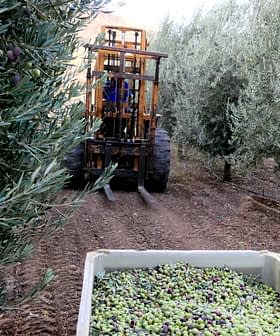Unusual Weather Leads to Dismal Harvest in California
Amid a harvest impacted by late winter temperature fluctuations, California is expecting a 30 percent drop in olive oil production this season.
In California, many olive farmers are scratching their heads after a series of unusual weather events has left this year’s olive harvest 25 percent lower than last year.
We are speculating a very warm period in February woke the trees up and a freeze in March shut them down.
“I have zero olives and will not harvest anything,” Jeff Martin, an olive farmer and award-winning producer based in Santa Clara County, told Olive Oil Times.
At his farm, roughly 35 miles south of San Jose, an unseasonably warm period at the end of winter caused the olive trees to bloom. These blooms were then damaged by an early spring frost, which rendered the trees barren for the rest of the harvest season.
“We are speculating a very warm period in February 2018 woke the trees up and a freeze in March shut them down,” he said. “In farming, you just have to live through the down years.”
Martin’s case is not an isolated incident. Many counties across California, but especially in the north and center of the state, were affected by these temperature fluctuations. Even some growers as far south as Ventura County reported frost damage.
“We won’t harvest for a couple of months still, but it is easy to tell that [our yield] will be much less, probably a 50 percent reduction,” Phil Asquith, the owner of Ojai Olive Oil, told Olive Oil Times. On top of the temperature fluctuations, Asquith said the hot summer took its toll on his trees as well.
“Swings in temperature from cold to hot, a ‘false spring’ followed by more heat, also searing heat waves up to 120 degrees [all damaged our crop].” he said.
However, not all producers were impacted equally by the weather. Several from different parts of California told Olive Oil Times that they were not affected at all by the late winter and early spring temperature fluctuations.
“We did not experience what others experienced as we are a bit warmer than other areas,” Karen Bond, the co-owner of Bondolio in Yolo County, told Olive Oil Times. She expects to see a slight decrease in her production this year, but attributed it to being an off year.
According to the California Olive Oil Council (COOC), which represents 90 percent of the state’s olive oil producers, there are more stories similar to those of Martin and Asquith than of Bond.
The council’s data indicates that California producers will press 2.8 million gallons of extra virgin olive oil this year; a decrease of 1.2 million from last year.
This is a disappointing figure for Patricia Darragh, the executive director of the COOC, but still not as bad as it could have been. Back in June, an unofficial estimate from the council forecasted that the yield may have decreased by as much as 35 percent.
In fact, Darragh is optimistic that this is only a bump in the road for California producers and said that prices will not be affected. She is not alone in her optimism. Every single producer interviewed by this reporter, even those unaffected by the temperature fluctuations, said he or she expected to have a better harvest next year.
However, there is no question in Darragh’s mind that the weather is responsible for this year’s substantial decrease.
“My understanding is that it is almost all weather-related,” Darragh told Olive Oil Times. “Even though olive trees are alternate-year bearing, that has not been significant to date in California.”
The big question looming for her and all of the state’s producers then becomes: will California become increasingly susceptible to late winter thaws followed by early spring freezes?
Two plant scientists and an agricultural engineer told Olive Oil Times back in June that they thought California is becoming more susceptible to these temperature fluctuations. There is currently no data available to confirm whether or not this is the case.
“However, there has been some anecdotal evidence of [these] events,” Kripa Jagannathan, a member of the Energy and Resources Group at UC Berkeley, told Olive Oil Times. “So we are trying to dig into the data to see what we can find.”
Jagannathan is part of a team that is studying how the freeze risk for sub-tropical and deciduous trees in California will be impacted by climate change.
She said the team is still in the very initial stage of their research, but does have one working hypothesis: the last frost date is changing more slowly than the rate at which the spring is warming. This would lead to trees blooming earlier in the season and cause them to be more susceptible to harm from that lingering last frost date.
“If the last frost date advances at a rate slower than the phenological shift in bloom times, then trees are likely to experience an increased frost risk,” she said.
Paul Ullrich is the head of the UC Davis Climate and Global Change Group. He told Olive Oil Times that abrupt temperature fluctuations, such as the ones experienced earlier this year in California, are caused by cold air escaping from the polar jet stream and blowing into lower latitudes.
“On the purely meteorological sidemid-latitudesthese abrupt temperature fluctuations are nominally caused by arctic air intrusion, where cold arctic air is able to escape into the midlatitudes because of a weak polar jet stream,” he said.
According to data kept by the National Oceanic and Atmospheric Administration, polar intrusions throughout the middle of March lowered California’s daily average temperatures substantially compared with previous years. This phenomenon is likely to have lead to the frost events that damaged so much of California’s olive crop.
While there is no solid evidence linking climate change to a weakening polar jet stream, Ullrich said this link should be investigated further.
“Although it hasn’t been proven definitively, it is theorized that under climate change we will see a weaker polar jet because of loss of arctic sea ice, which would then lead to a higher probability of a cold air intrusion event,” he said.
In other words, California producers may have to brace for more February thaws followed by March freezes.








